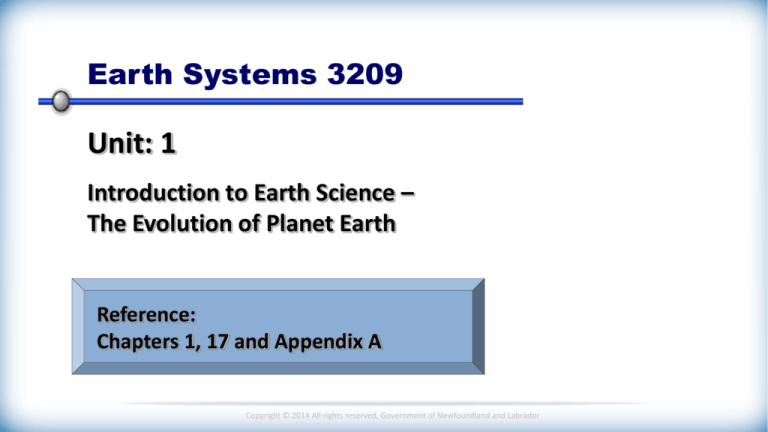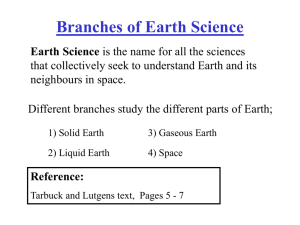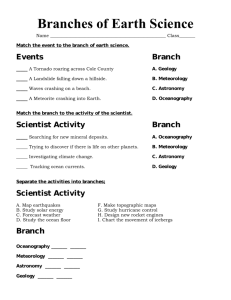
Earth Systems 3209
Unit: 1
Introduction to Earth Science –
The Evolution of Planet Earth
Reference:
Chapters 1, 17 and Appendix A
Copyright © 2014 All rights reserved, Government of Newfoundland and Labrador
Unit 1:
Topic 1.1
Branches of Earth Science
Focus on . . .
Identify the major branches of Earth Science
Identify the various fields within each branch
Relate the branches to other scientific fields
Copyright © 2014 All rights reserved, Government of Newfoundland and Labrador
Branches of Earth Science
Earth Science is the name for all the sciences
that collectively seek to understand Earth and
its neighbours in space.
Different branches study the different parts of Earth;
1) Solid Earth
3) Gaseous Earth
2) Liquid Earth
4) Space
Copyright © 2014 All rights reserved, Government of Newfoundland and Labrador
Solid Earth
Geology – study of the solid Earth
• Divided into two broad areas;
1) Physical Geology - examines the materials
composing Earth and seeks to understand processes
that operate beneath and upon its surface.
2) Historical Geology – seeks an understanding of the
origin of Earth and the development of the planet
through its 4.6 billion year history.
Copyright © 2014 All rights reserved, Government of Newfoundland and Labrador
Solid Earth
Crystallography – study of the arrangement of
atoms in solids
Mineralology – study of minerals
Volcanology – study of volcanic activity
Petrology – study of the origin, composition
and structure of rocks
Sedimentology – study of sediment and the
processes involved in their deposition
Copyright © 2014 All rights reserved, Government of Newfoundland and Labrador
Solid Earth
Stratigraphy – study of rock layering
Geomorphology – study of landscape features
on Earth
Paleontology – study of fossils and life on Earth
Seismology – study of earthquakes and
seismic waves
Copyright © 2014 All rights reserved, Government of Newfoundland and Labrador
Liquid Earth
Oceanography
• study of the oceans and oceanic phenomena
• study of the composition and movements of sea water, as .
well as coastal processes, seafloor topography, and marine life
Hydrology
• study of Earth’s fresh water systems
• including, rivers, streams, and groundwater
Copyright © 2014 All rights reserved, Government of Newfoundland and Labrador
Gaseous Earth
Meteorology – study of the atmosphere;
weather and climate
Space
Astronomy – the scientific study of the
universe and the relationship between Earth
and the universe. It focuses on the
observation and interpretation of celestial
bodies in space.
Copyright © 2014 All rights reserved, Government of Newfoundland and Labrador
Connections with other Sciences …..
the study of fossils (i.e. paleontology) demonstrates the
evolution of life, which is clearly related to biology
the study of rock and mineral compositions would utilize
chemistry
the forces that create faults and folds would be studied
through physics
Copyright © 2014 All rights reserved, Government of Newfoundland and Labrador
Example 1:
Which of the following branches of Earth Science
focus on the study of atmospheric conditions?
(A) astronomy
(B) meteorology
(C) seismology
(D) paleontology
Copyright © 2014 All rights reserved, Government of Newfoundland and Labrador
Example 2:
Which branch of Earth Science focuses on the
study of fossils?
(A) astronomy
(B) meteorology
(C) palaeontology
(D) seismology
Copyright © 2014 All rights reserved, Government of Newfoundland and Labrador
Your Turn . . .
Take the time and complete the following questions . . .
(Solutions to follow)
Questions:
Which branch of Earth Science focuses on the study of Earth’s water systems?
(A) hydrology
(B) palaeontology
(C) petrology
(D) seismology
Which branch of Earth Science would most likely study the origin of meteorites?
(A) astronomy
(B) geology
(C) meteorology
(D) oceanography
Copyright © 2014 All rights reserved, Government of Newfoundland and Labrador
Solutions . . .
Questions:
Which branch of Earth Science focuses on the study of Earth’s water systems?
(A) hydrology
(B) palaeontology
(C) petrology
(D) seismology
Which branch of Earth Science would most likely study the origin of meteorites?
(A) astronomy
(B) geology
(C) meteorology
(D) oceanography
Copyright © 2014 All rights reserved, Government of Newfoundland and Labrador
Common Errors and Misconceptions
Meteorology is the study of the atmosphere
which focuses on weather and climate,
whereas, meteorites fall under the study of
astronomy.
The impact meteorites have on Earth’s surface
falls under the study of Geology.
Copyright © 2014 All rights reserved, Government of Newfoundland and Labrador
Summary . . .
Overview of Points covered:
Their are four main branches of Earth Sciences which are
closely connected to other branches as outlined below:
Geology
Oceanography Meteorology Astronomy
Crystallography;
Geomorphology;
Mineralogy;
Paleontology;
Petrology;
Seismology;
Stratigraphy;
Volcanology;
Sedimentology
Hydrology
Copyright © 2014 All rights reserved, Government of Newfoundland and Labrador








